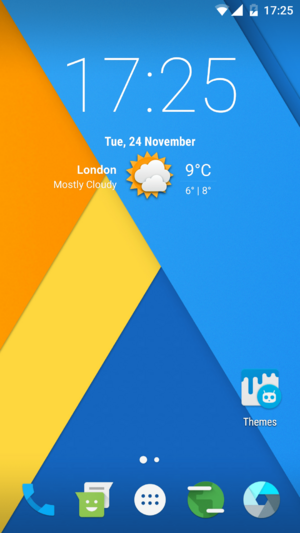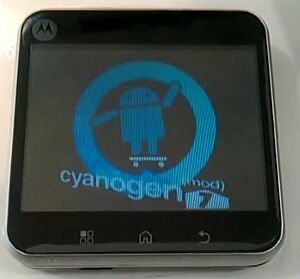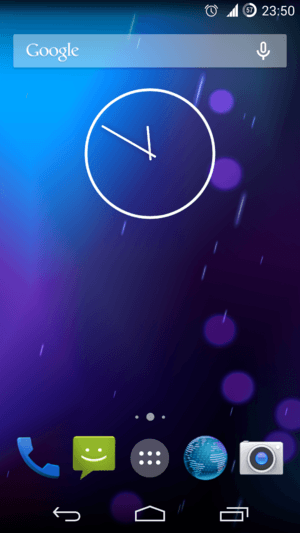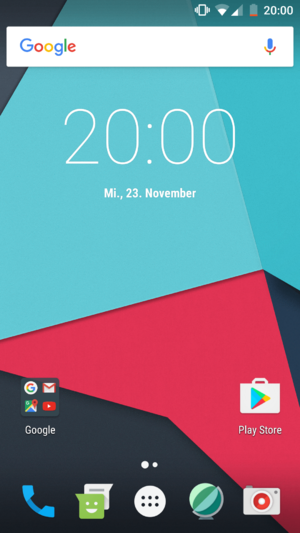CyanogenMod facts for kids
 |
|

The default CyanogenMod 13 homescreen, based on Android 6.0 "Marshmallow"
|
|
| Company / developer | CyanogenMod open-source community |
|---|---|
| Programmed in | C (core), C++ (some third-party libraries), Java (UI) |
| OS family | Android (Linux) |
| Working state | Discontinued |
| Source model | Open source |
| Initial release | 3.1 (Dream & Magic) 1 July 2009 |
| Discontinued | 13.0 ZNH5YAO (from Android 6.0.1 r61) / 20 December 2016 |
| Latest unstable release | 14.1 nightly build / 25 December 2016 |
| Marketing target | Firmware replacement for Android mobile devices |
| Available language(s) | |
| Update method | Over-the-air (OTA), ROM flashing |
| Package manager | APK-based |
| Supported platforms | ARM, x86 |
| Kernel type | Monolithic (Linux) |
| Default user interface | Android Launcher (3, 4) ADW Launcher (5, 6, 7) Trebuchet Launcher (9, 10, 11, 12, 13, 14) |
| License | Apache License 2 and GNU GPL v2, with some proprietary libraries |
CyanogenMod (/saɪˈænoʊdʒɛnmɒd/ sy-AN-oh-JEN-mod; CM) was a special kind of operating system for mobile phones and tablets. It was based on Android, which is the system many phones use. CyanogenMod was unique because it was open-source, meaning its code was free for anyone to see and change.
This system was developed from 2009 to 2016. It took the official Android versions from Google and added new features and improvements. Many people used CyanogenMod on their phones, with reports suggesting over 50 million users at one point. It was also a popular starting point for other developers who wanted to create their own custom Android versions.
CyanogenMod offered many cool features that weren't usually found in the standard Android that came with phones. These included custom themes, better sound quality (with FLAC support), and a special "Privacy Guard" to control app permissions. It also allowed users to connect their phone to a computer for internet (tethering) and even make their phone run faster (overclocking). Developers of CyanogenMod said it didn't have any unwanted programs or spyware. They also claimed it made phones run better and more reliably.
In 2013, the person who started CyanogenMod, Stefanie Jane, created a company called Cyanogen Inc. The idea was to make the project bigger and more commercial. However, things didn't go as planned. In 2016, Stefanie Jane left the company. The company then stopped its services. Because the original code was open-source, other developers took it and continued working on it. This new project is now known as LineageOS.
Contents
How CyanogenMod Started
Soon after the first Android phone, the HTC Dream, came out in 2008, people found a way to get full control over its software. This was called "root access". Since Android is open-source, having root access meant people could change and install new software on their phones.
In 2009, many people started making their own modified Android software. One popular version was made by a developer named JesusFreke. When Google released an update that stopped root access, he made versions that brought it back. Later, in August 2009, he suggested users switch to a version improved by another developer named Cyanogen (Stefanie Jane). This version was called "CyanogenMod." The name combines "Cyanogen" (Stefanie Jane's nickname) and "Mod," which means a user-made modification.
Growing the Community
CyanogenMod quickly became very popular. A group of developers, called the CyanogenMod Team, helped add new features and support more devices. It became one of the most well-known custom Android systems.
Like many open-source projects, CyanogenMod was built by many people working together. Developers would suggest new features or fix problems. Other users could test these changes, and then a few main developers would add them to the official code.
CyanogenMod also changed its main home screen app over time. It first used ADW.Launcher, which offered more ways to customize the phone. Later, starting with version 9, CyanogenMod created its own home screen app called Trebuchet.
Initially, CyanogenMod released updates often, including "nightly" builds (daily updates) and "stable" versions. Later, they switched to a "rolling release" model, where they released "milestone" (M-builds) versions each month. These M-builds were considered stable enough for daily use.
CyanogenMod Versions
CyanogenMod had many versions, each based on a different version of Android. Here's a quick look at some of them:
| CM Version | Based on |
|---|---|
| CyanogenMod 3 | Android 1.5 (Cupcake) |
| CyanogenMod 4 | Android 1.6 (Donut) |
| CyanogenMod 5 | Android 2.x.x (Eclair) |
| CyanogenMod 6 | Android 2.2.x (Froyo) |
| CyanogenMod 7 | Android 2.3.x (Gingerbread) |
| CyanogenMod 9 | Android 4.0.x (Ice Cream Sandwich) |
| CyanogenMod 10/10.1/10.2 | Android 4.x.x (Jelly Bean) |
| CyanogenMod 11 | Android 4.4.x (KitKat) |
| CyanogenMod 12 | Android 5.0.x (Lollipop) |
| CyanogenMod 12.1 | Android 5.1.x (Lollipop) |
| CyanogenMod 13 | Android 6.0.x (Marshmallow) |
| CyanogenMod 14 | Android 7.0 (Nougat) |
| LineageOS 14.1 | Android 7.1.x (Nougat) |
CyanogenMod 7: Gingerbread Era
CyanogenMod 7 was built on Android 2.3 Gingerbread. The CyanogenMod Team added their own special code to it. Stefanie Jane wrote most of this code, but other developers also helped.
Development for CyanogenMod 7 started when Google released Android 2.3's code. The first test versions came out in February 2011. The final public version of CyanogenMod 7.0 was released in April 2011. Later updates, like 7.2 in June 2012, added features such as a smart phone dialer and lock-screen updates.
CyanogenMod 8: The Skipped Version
CyanogenMod 8 was supposed to be based on Android 3.x Honeycomb. However, Google didn't release the full code for Honeycomb until later. So, the CyanogenMod team decided to skip version 8 and go straight to CyanogenMod 9.
CyanogenMod 9: Ice Cream Sandwich
CyanogenMod 9 was based on Android 4.0 Ice Cream Sandwich. This was the first version to use CyanogenMod's own Trebuchet launcher. Stefanie Jane and her team started working on it after Google released the Android 4.0.1 code. This version took longer to develop because there were big changes between Android 2.3 and 4.0.
Test versions were released in late 2011. The finished CyanogenMod 9 was released in August 2012. A small update, version 9.1.0, came out later with bug fixes and an app for NFC payments.
In April 2012, CyanogenMod introduced its new mascot, "Cid." Cid is short for "Cyanogenmod ID" and replaced the old mascot, Andy the skateboarding "bugdroid."
CyanogenMod 10: Jelly Bean
In July 2012, the CyanogenMod team announced that CyanogenMod 10 would be based on Android 4.1 Jelly Bean. They started releasing daily test builds for many devices. They also began monthly "M-series" releases, which were more stable.
- CyanogenMod 10.0: Final stable builds were released in November 2012.
- CyanogenMod 10.1: Based on Android 4.2 Jelly Bean. Stable builds were released in June 2013.
- CyanogenMod 10.2: Based on Android 4.3 Jelly Bean. It started rolling out in August 2013. This version added new features like Bluetooth Low Energy and better graphics support.
CyanogenMod 11: KitKat
On November 6, 2013, the CyanogenMod team started working on CyanogenMod 11, based on Android 4.4 KitKat. The first daily test builds came out in December 2013. Monthly M-builds were released, offering a more stable experience than the daily builds.
The OnePlus One phone came with a special version of CyanogenMod 11 called "CyanogenMod 11S."
CyanogenMod 12: Lollipop
The first daily test builds of CyanogenMod 12, based on Android 5.0 Lollipop, were released in January 2015. A stable version was released in June 2015.
- CyanogenMod 12.1: Based on Android 5.1. The first daily test builds were announced in April 2015. A stable version was released in September 2015.
CyanogenMod 13: Marshmallow
The first daily test builds of CyanogenMod 13.0, based on Android 6.0, were released in November 2015 for a few devices. It was later updated to be based on Android 6.0.1. The first stable builds were released in March 2016.
CyanogenMod 14.0 and 14.1: Nougat
Because Android 7.1 was released quickly, CyanogenMod skipped making daily builds for CyanogenMod 14.0. Instead, they moved features to the cm-14.1 branch.
The first test build of CyanogenMod 14.1, based on Android 7.1, came out in November 2016. Official daily builds started soon after for many devices. This version was still a "work in progress" and was missing some of CyanogenMod's usual features. It was the last version to use the "CyanogenMod" name.
What Happened Next: LineageOS
In December 2016, the CyanogenMod developer group decided to create a new project. They renamed the CyanogenMod code to LineageOS. This new project continued the work based on CyanogenMod versions 13 and 14.1. The LineageOS Project is now supported by the community. LineageOS version 15.1 was the first fully controlled by the new team, but it still has many features from CyanogenMod.
Cyanogen Inc.: The Company
Cyngn Inc. (originally Cyanogen Inc.) was an American company started in September 2013. Its goal was to make money from the CyanogenMod project. The company received a lot of money from investors.
Challenges of Commercialization
When Cyanogen Inc. was formed, some people in the CyanogenMod community were worried. They felt that developers who had given their work for free might not be recognized or paid fairly now that it was a commercial project. They also worried that the original spirit of the community project was being lost.
Stefanie Jane, the founder, tried to reassure the community. She explained that most of CyanogenMod used a license that allowed commercial use. She said the company had no plans to close the source code or change the license of any code contributed to the project.
In January 2015, it was reported that Microsoft had invested in Cyanogen. In April 2015, Cyanogen announced a partnership with Microsoft to include Microsoft apps and services in Cyanogen OS.
Company Changes and End of Services
Even though CyanogenMod was very popular as a custom Android system, Cyanogen Inc. had trouble convincing phone companies to use its version of Android. In July 2016, the company laid off many staff and closed offices. The CEO also stepped down, and Stefanie Jane left the company in November 2016.
Many people thought the company's problems were due to poor management decisions. For example, in 2014, the company ended its partnership with OnePlus, a phone company, which caused problems for OnePlus in India. Cyanogen's CEO also famously said they wanted to take control of Android from Google.
After leaving, Stefanie Jane wrote that she had trusted the "wrong people" and that they didn't share her vision. She noted that the community had lost the rights to the "CyanogenMod" name. She asked the community to consider taking the open-source code and starting a new project.
On December 23, 2016, Cyanogen Inc. announced it was shutting down the systems that supported CyanogenMod. Soon after, the main CyanogenMod project changed its name to LineageOS. The developers wanted to go back to the project's community roots. They decided not to use the "Cyanogen" or "CyanogenMod" names because of the company's actions and possible legal issues.
The company, now called Cyngn Inc., later changed its focus from mobile operating systems to self-driving car systems.
How Phone Makers Reacted
At first, phone makers and mobile carriers didn't like custom software like CyanogenMod. They worried about phones not working right and the costs of supporting unofficial software. Also, custom software sometimes offered features, like internet tethering, that carriers usually charged extra for. Because of this, many devices made it hard to install custom software.
However, as community-made software became more popular, and after a US ruling allowed "jailbreaking" mobile devices, manufacturers and carriers became more open to CyanogenMod. Some companies like HTC, Motorola, Samsung, and Sony Ericsson even started supporting and encouraging its development.
By 2011, it became easier to install custom software because more devices came with "unlockable" bootloaders. This meant users could change the phone's software more easily. Some phone makers even released "developer editions" of phones that were already unlocked. Samsung sent phones to the CyanogenMod team to help them bring CyanogenMod to those devices.
Licensing and Google Apps
Before version 4.1.11.1, CyanogenMod included some apps from Google, like Gmail and Play Store. These apps were usually part of the Android that came with phones, but they weren't free to distribute. In September 2009, Google told Stefanie Jane to stop distributing these apps.
After discussions between Google and Cyanogen, they agreed that CyanogenMod could continue. However, it would not directly include Google's apps. Users could still get these apps separately if they wanted to.
CyanogenMod also had to deal with issues related to proprietary (closed-source) hardware drivers. Stefanie Jane worked to resolve these issues, sometimes with help from Google employees.
Replicant is another custom Android system that is based on CyanogenMod. It removes all proprietary software and drivers to avoid legal issues. However, this means Replicant doesn't support many newer phones that rely on these drivers.
Version History Overview
| CyanogenMod Version | Based on Android | Last or Major Release | Key Changes |
|---|---|---|---|
| 1 | Android 1.0 | None | Never Released |
| 2 | Android 1.1 (Petit Four) |
None | Never Released |
| 3 | Android 1.5 (Cupcake) |
3.6.8.1 | 3.6.8 onwards based on Android 1.5r3 |
| 3.9.3 | 3.9.3 onwards has FLAC support | ||
| 4 | Android 1.5/1.6 (Cupcake/Donut) |
4.1.4 | 4.1.4 onwards based on Android 1.6 (Donut); Google proprietary software separated due to cease and desist from 4.1.99 onwards |
| 4.2.15.1 | 4.2.3 onwards has USB tethering support; 4.2.11 onwards added pinch zoom for Browser and Gallery. | ||
| 5 | Android 2.0/2.1 (Eclair) |
5.0.8 | Introduced ADW.Launcher as the default launcher. |
| 6 | Android 2.2 (Froyo) |
6.0.0 | Introduced dual camera and ad hoc Wi-Fi support, faster performance. |
| 6.1.3 | 6.1.0 onwards based on Android 2.2.1. | ||
| 7 | Android 2.3 (Gingerbread) |
7.0.3 | 7.0.0 onwards based on Android 2.3.3 |
| 7.1.0 | Based on Android 2.3.7 | ||
| 7.2.0 | New devices, updated translations, predictive phone dialer, lock-screen updates, many bug fixes. | ||
| 8 | Android 3.x (Honeycomb) |
N/A | CyanogenMod 8 was never released. |
| 9 | Android 4.0 (Ice Cream Sandwich) |
9.1 | Deactivated root usage by default. Introduced Cyanogen's own launcher, Trebuchet. |
| 10 | Android 4.1 (Jelly Bean) |
10.0.0 | Expandable desktop mode. Built-in file manager. |
| Android 4.2 (Jelly Bean) |
10.1.3 | ||
| Android 4.3 (Jelly Bean) |
10.2.1 | Phone: Blacklist-Feature added. | |
| 11 | Android 4.4 (KitKat) |
11.0 XNG3C | WhisperPush: Secure messaging feature (discontinued in 2016). CyanogenMod ThemeEngine: new powerful theme engine. |
| 12 | Android 5.0 (Lollipop) |
12.0 YNG4N | LiveDisplay: advanced display management tool. Updates to theme engine. UI Revamp: all applications updated to material theme. New audio apps. |
| Android 5.1 (Lollipop) |
12.1 YOG7DAO | CyanogenPlatform SDK: allows developers to add custom features. | |
| 13 | Android 6.0 (Marshmallow) |
13.0 ZNH5YAO | Wi-Fi Tethering, profiles, Do Not Disturb mode, Privacy Guard, Bluetooth Devices battery support, Lockscreen Wallpaper picker, Snap Camera, Gello Browser, and more. |
| 14 | Android 7.0 (Nougat) |
N/A | Skipped, as Android 7.1 was released quickly. |
| Android 7.1 (Nougat) |
14.1 | Considered a "work in progress" and missing some features. Succeeded by LineageOS. |
Cyanogen OS: The Commercial Version
Cyanogen also developed a commercial operating system called Cyanogen OS. This version came already installed on some phones, like the OnePlus One and phones from YU Televentures.
Cyanogen OS often included extra apps, like Google Play, and a set of special software called C-Apps. CyanogenMod, the community version, did not include these by default, but users could add them if they wanted.
Initially, the commercial version was called "CyanogenMod 11S." With version 12, it was renamed to Cyanogen OS. It was possible to install CyanogenMod (the community version) on devices that came with Cyanogen OS.
CyanogenMod vs. Cyanogen OS
Here's a simple comparison between the two:
| Name | What it is | Based on: | How to get it | Root access (Superuser)? | Who developed it: |
|---|---|---|---|---|---|
| Cyanogen OS | Software that came pre-installed on some phones. | Android Open Source Project. | Comes pre-installed on some devices. | No | Cyanogen Inc. |
| CyanogenMod | Software you could install yourself on Android devices. | Manual installation required | Yes | Cyanogen (Stefanie Jane) and the CyanogenMod community |
Supported Devices
CyanogenMod officially supported many different mobile devices. This included most Nexus and Google Play Edition devices. They provided stable versions and daily test versions for over 150 different devices.
More to Explore
- Android rooting
- Comparison of mobile operating systems
- List of custom Android firmware
- List of free and open-source Android applications
- Open-source software
See also
 In Spanish: CyanogenMod para niños
In Spanish: CyanogenMod para niños




